Apoptotic adipose-derived mesenchymal stem cell therapy protects against lung and kidney injury in sepsis syndrome caused by cecal ligation puncture in rats
- PMID: 24451364
- PMCID: PMC4054966
- DOI: 10.1186/scrt385
Apoptotic adipose-derived mesenchymal stem cell therapy protects against lung and kidney injury in sepsis syndrome caused by cecal ligation puncture in rats
Abstract
Introduction: We tested the hypothesis that apoptotic adipose-derived mesenchymal stem cells (A-ADMSC) are superior to healthy (H)-ADMSC in attenuating cecal ligation puncture (CLP)-induced sepsis-mediated lung and kidney injuries.
Methods: Adult male rats divided into group 1 (sham controls), group 2 (CLP), group 3 [CLP + H-ADMSC administered at 0.5, 6, and 18 hours after CLP], and group 4 [CLP + A-ADMSC administered as in group 3] were sacrificed 72 hours after CLP with blood, lung, and kidney collected for studies.
Results: White blood cell (WBC) count, circulating TNF-α and creatinine levels were higher in groups 2 and 3 than in groups 1 and 4 (all P < 0.001). Kidney and lung damage scores were highest in group 2, lowest in group 1, significantly higher in group 3 than in group 4 (all P < 0.0001). Protein expressions of inflammatory (ICAM-1, MMP-9, TNF-α, NF-κB), oxidative, and apoptotic (Bax, caspase-3, PARP) biomarkers were higher in groups 2 and 3 than groups 1 and 4, whereas anti-apoptotic (Bcl-2) and mitochondrial integrity (cytochrome-C) biomarkers were lower in groups 2 and 3 than in groups 1 and 4 (all P < 0.001). Expressions of anti-oxidant biomarkers at protein (GR, GPx, NQO-1, HO-1) and cellular (GR, GPx) levels were highest in group 4 (all P < 0.001). The number of inflammatory cells (CD3+) in lungs and levels of DNA damage marker (γ-H2AX) in kidneys were higher in groups 2 and 3 than in groups 1 and 4 (all P < 0.001).
Conclusions: A-ADMSC therapy was superior to H-ADMSC therapy in protecting major organs from damage in rats with CLP-induced sepsis syndrome.
Figures
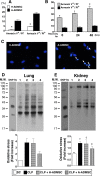
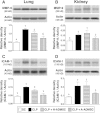
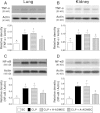
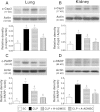
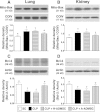
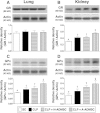
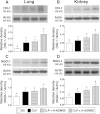
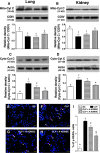

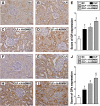
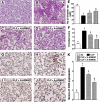
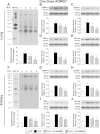
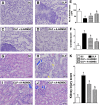
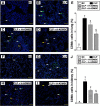
Similar articles
-
Impact of apoptotic adipose-derived mesenchymal stem cells on attenuating organ damage and reducing mortality in rat sepsis syndrome induced by cecal puncture and ligation.J Transl Med. 2012 Dec 7;10:244. doi: 10.1186/1479-5876-10-244. J Transl Med. 2012. PMID: 23217183 Free PMC article.
-
Additional benefit of combined therapy with melatonin and apoptotic adipose-derived mesenchymal stem cell against sepsis-induced kidney injury.J Pineal Res. 2014 Aug;57(1):16-32. doi: 10.1111/jpi.12140. Epub 2014 May 15. J Pineal Res. 2014. PMID: 24761983
-
Melatonin augments apoptotic adipose-derived mesenchymal stem cell treatment against sepsis-induced acute lung injury.Am J Transl Res. 2014 Oct 11;6(5):439-58. eCollection 2014. Am J Transl Res. 2014. PMID: 25360211 Free PMC article.
-
Combination of adipose-derived mesenchymal stem cells (ADMSC) and ADMSC-derived exosomes for protecting kidney from acute ischemia-reperfusion injury.Int J Cardiol. 2016 Aug 1;216:173-85. doi: 10.1016/j.ijcard.2016.04.061. Epub 2016 Apr 14. Int J Cardiol. 2016. PMID: 27156061
-
Combined Therapy With Adipose-Derived Mesenchymal Stem Cells and Ciprofloxacin Against Acute Urogenital Organ Damage in Rat Sepsis Syndrome Induced by Intrapelvic Injection of Cecal Bacteria.Stem Cells Transl Med. 2016 Jun;5(6):782-92. doi: 10.5966/sctm.2015-0116. Epub 2016 Apr 13. Stem Cells Transl Med. 2016. PMID: 27075767 Free PMC article.
Cited by
-
Ferroptotic MSCs protect mice against sepsis via promoting macrophage efferocytosis.Cell Death Dis. 2022 Sep 26;13(9):825. doi: 10.1038/s41419-022-05264-z. Cell Death Dis. 2022. PMID: 36163182 Free PMC article.
-
The Current Status of Mesenchymal Stromal Cells: Controversies, Unresolved Issues and Some Promising Solutions to Improve Their Therapeutic Efficacy.Front Cell Dev Biol. 2021 Mar 16;9:650664. doi: 10.3389/fcell.2021.650664. eCollection 2021. Front Cell Dev Biol. 2021. PMID: 33796536 Free PMC article. Review.
-
The short-term and long-term effects of intranasal mesenchymal stem cell administration to noninflamed mice lung.Front Immunol. 2022 Sep 16;13:967487. doi: 10.3389/fimmu.2022.967487. eCollection 2022. Front Immunol. 2022. PMID: 36189248 Free PMC article.
-
Molecular Crosstalk Between Macrophages and Mesenchymal Stromal Cells.Front Cell Dev Biol. 2020 Dec 9;8:600160. doi: 10.3389/fcell.2020.600160. eCollection 2020. Front Cell Dev Biol. 2020. PMID: 33363157 Free PMC article. Review.
-
Apoptotic mesenchymal stem cells and their secreted apoptotic extracellular vesicles: therapeutic applications and mechanisms.Stem Cell Res Ther. 2025 Feb 21;16(1):78. doi: 10.1186/s13287-025-04211-x. Stem Cell Res Ther. 2025. PMID: 39985021 Free PMC article. Review.
References
-
- Dellinger RP, Levy MM, Carlet JM, Bion J, Parker MM, Jaeschke R, Reinhart K, Angus DC, Brun-Buisson C, Beale R, Calandra T, Dhainaut JF, Gerlach H, Harvey M, Marini JJ, Marshall J, Ranieri M, Ramsay G, Sevransky J, Thompson BT, Townsend S, Vender JS, Zimmerman JL, Vincent JL. International Surviving Sepsis Campaign Guidelines Committee; American Association of Critical-Care Nurses; American College of Chest Physicians; American College of Emergency Physicians; Canadian Critical Care Society; European Society of Clinical Microbiology and Infectious Diseases et al.Surviving Sepsis Campaign: international guidelines for management of severe sepsis and septic shock: 2008. Crit Care Med. 2008;4:296–327. doi: 10.1097/01.CCM.0000298158.12101.41. - DOI - PubMed
Publication types
MeSH terms
Substances
LinkOut - more resources
Full Text Sources
Other Literature Sources
Medical
Research Materials
Miscellaneous

